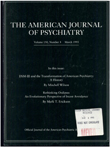50-year trends in the incidence of anorexia nervosa in Rochester, Minn.: a population-based study
Abstract
OBJECTIVE: The aim of the study was to determine incidence and prevalence rates and long-term trends in incidence of anorexia nervosa by identifying all persons residing in the community of Rochester, Minn., during the 50-year period 1935 through 1984 who had the disorder. METHOD: From a community-based epidemiologic resource, 13,559 medical records with diagnoses of amenorrhea, starvation, weight loss, anorexia nervosa, or other conditions were screened to identify true cases of anorexia nervosa determined by using standard diagnostic criteria. RESULTS: One hundred eighty-one residents (166 female and 15 male) fulfilled the diagnostic criteria for anorexia nervosa; these were the incidence cases. Due to a quadratic trend in the rates for girls 10-19 years old, the incidence rate among female residents fell from 16.6 per 100,000 person-years in the 1935-1939 period to a low of 7.0 in 1950-1954 and increased to 26.3 in 1980-1984. The incidence rates for women 20 years old and older and for males remained constant. For females 15-24 years old, there was a linear increase. The overall age-adjusted incidence rate per 100,000 person-years was 14.6 for females and 1.8 for males. The prevalence rate per 100,000 population was 269.9 for females and 22.5 for males. CONCLUSIONS: Anorexia nervosa is more common than previously recognized. Among girls 15-19 years old it is a very common chronic illness. Its incidence has increased among females 15-24 years old but not among older women or among males.
Access content
To read the fulltext, please use one of the options below to sign in or purchase access.- Personal login
- Institutional Login
- Sign in via OpenAthens
- Register for access
-
Please login/register if you wish to pair your device and check access availability.
Not a subscriber?
PsychiatryOnline subscription options offer access to the DSM-5 library, books, journals, CME, and patient resources. This all-in-one virtual library provides psychiatrists and mental health professionals with key resources for diagnosis, treatment, research, and professional development.
Need more help? PsychiatryOnline Customer Service may be reached by emailing [email protected] or by calling 800-368-5777 (in the U.S.) or 703-907-7322 (outside the U.S.).



